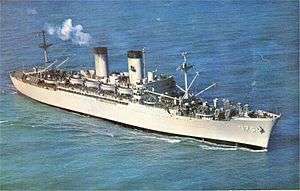USS General J. C. Breckinridge (AP-176)
 USS General J. C. Breckinridge (T-AP-176) underway | |
| History | |
|---|---|
| Name: | USS General J. C. Breckinridge |
| Namesake: | General James Carson Breckinridge, US Marine Corps |
| Builder: | Federal Shipbuilding & Drydock |
| Launched: | 18 March 1945 |
| Sponsored by: | Mrs Dorothy T. Breckinridge |
| Commissioned: | 30 June 1945 |
| Reclassified: | T-AP-176 (1 October 1949) |
| Struck: | 1 December 1966 |
| Identification: | MC hull type P2-S2-R2 |
| Honors and awards: | Four service stars for Korean War service and one for the Vietnam War |
| Fate: | Scrapped 1988, Taiwan |
| General characteristics | |
| Class and type: | General John Pope class transport |
| Displacement: | 11,450 tons (lt) |
| Tons burthen: | 20,175 tons fully laden |
| Length: | 622 feet 7 inches (189.76 m) |
| Beam: | 75 feet 6 inches (23.01 m) |
| Draft: | 25 feet 6 inches (7.77 m) |
| Installed power: | 17,000 shp |
| Propulsion: | |
| Speed: | 21 knots (39 km/h) |
| Capacity: | 5,289 |
| Complement: | 466 |
| Armament: | 4 x single 5"/38 caliber dual purpose guns, 4 x 40mm guns, 20 x single 20mm guns |
USS General J. C. Breckinridge (AP-176) was a troopship that served with the United States Navy in World War II, the Korean War and the Vietnam War. In October 1949 she was redesignated T-AP-176 but retained her Navy crew.
USS General J. C. Breckinridge, a General John Pope class troop transport, was built under Maritime Commission contract by the Federal Shipbuilding & Drydock Company at Kearny, New Jersey.
World War II
She was commissioned with a United States Coast Guard crew in June 1945 and was en route to Marseille on her first operational voyage when the surrender of Japan ended World War II.
Peacetime service
The transport made four more voyages to France to bring troops home, then was transferred to the Pacific, arriving at San Francisco in January 1946. A Navy crew replaced her Coast Guard crew there in February, probably after she was selected as one of six ships of her class to be retained in the postwar commissioned fleet. Following five trans-Pacific voyages, between October 1946 and January 1947 General J. C. Breckinridge was then converted at Philadelphia for peacetime employment, with special facilities for military dependents. She retained her armament but lost some of her lifeboats. Breckinridge then returned to the Pacific where she maintained a busy schedule of voyages between the west coast of the United States and numerous points in the Western Pacific.
In October 1949 all the ships in the Naval Transportation Service were reassigned to the newly created Military Sea Transportation Service (MSTS). As a ship operationally subordinate to MSTS she was redesignated T-AP-176, but because she was a commissioned vessel with a Navy, not civilian, crew, General J. C. Breckinridge retained the designation "USS" instead of becoming "USNS."
Korean War
In July 1950, immediately after the outbreak of the Korean War, General J. C. Breckinridge was reconverted to a troop transport at San Francisco and in August carried troops from Seattle to Yokosuka, Japan. She was diverted from her return voyage to support the assault on Inchon, where she arrived with fresh troops the day after the landing. In November 1950 she assisted in the evacuation of Wonsan, and in December she helped evacuate Hungnam.
General J. C. Breckinridge made two more troop voyages in the war in Korea and then returned to regular MSTS transport duty, carrying both military and civilian passengers throughout the Pacific area. In 1955 she was again modified, losing her armament and receiving additional lifeboats. She remained an active part of the MSTS nucleus fleet as one of its few commissioned ships until December 1965, when she was inactivated and turned over to the Maritime Administration for layup in its reserve fleet.
Vietnam War
Some sources record the ship as having played a small role in the Vietnam War in 1965 and receiving a service star for her service there. She landed troops off the coast of Vung Tau in Vietnam in May 1965. In June 1965 she landed troops at Cam Ranh Bay, Nha Trang and Qui Nhon.[1] Breckenridge also made at least one other voyage to South Vietnam in 1965, dropping off troops at Cam Ranh Bay and Qui Nhon (and perhaps other ports) from 11–17 September. Point of departure was Oakland, Calif., on or about 10 August.
Decommission
General J. C. Breckinridge was stricken from the Naval Vessel Register and permanently transferred to the Maritime Administration in December 1966. The Maritime Administration sold her in August 1987 to a Japanese firm for scrapping.
Awards
General J. C. Breckinridge received four service stars for Korean War service and one for Vietnam War service.
References
- ↑ Oral History Interview from Lee Lewandowski who spoke from personal experience.
- USS General J. C. Breckinridge (AP-176), Navsource Online.
- This article incorporates text from the public domain Dictionary of American Naval Fighting Ships. The entry can be found here.